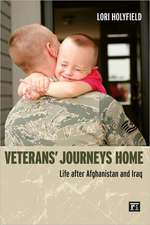When the Warrior Returns: Making the Transition at Home
Patty Shinseki Editat de Nathan D. Ainspan, Walter E. Penken Limba Engleză Paperback – 14 sep 2012
Preț: 160.83 lei
Nou
Puncte Express: 241
Preț estimativ în valută:
30.78€ • 32.01$ • 25.41£
30.78€ • 32.01$ • 25.41£
Carte disponibilă
Livrare economică 24 martie-07 aprilie
Preluare comenzi: 021 569.72.76
Specificații
ISBN-13: 9781612510903
ISBN-10: 1612510906
Pagini: 291
Dimensiuni: 152 x 226 x 23 mm
Greutate: 0.52 kg
Editura: US Naval Institute Press
ISBN-10: 1612510906
Pagini: 291
Dimensiuni: 152 x 226 x 23 mm
Greutate: 0.52 kg
Editura: US Naval Institute Press
Recenzii
"When the Warrior Returns: Making the Transition at Home is an excellent overview of the issues and any warrior or family may face as the warrior returns home. The book is written in a straight forward and realistic manner addressing the challenges these families face including many practical tips and recommendations. I would strongly recommend this book to families and practitioners alike as it clearly outlines the challenges, makes realistic recommendations and provides numerous valuable resources. Should be a part of every military or VA practitioner's library."--David L. Kennedy, LCSW, CAPT, MSC, USN (Ret.)















